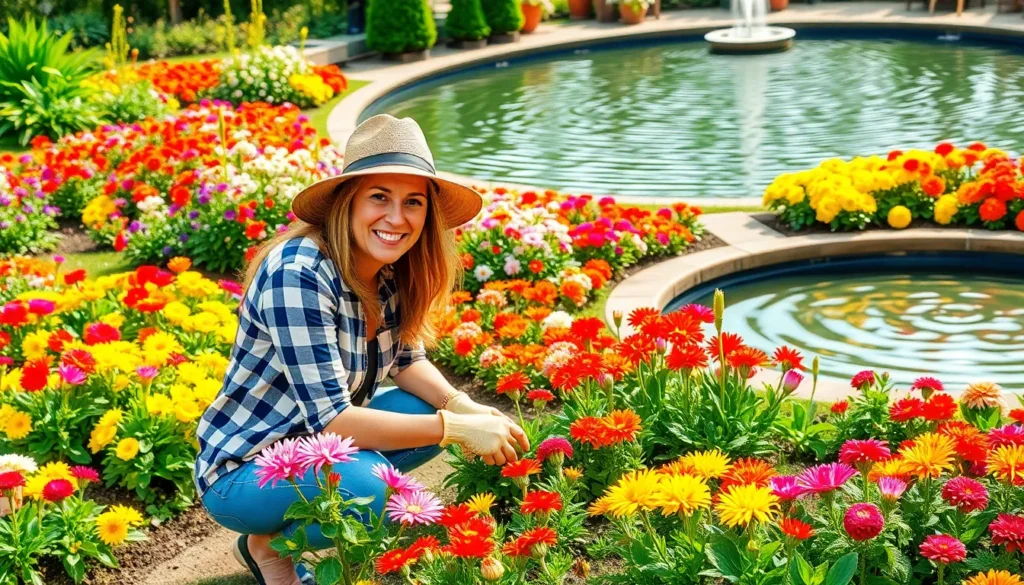Table of Contents
ToggleTransforming outdoor spaces into stunning landscapes requires not just creativity but also inspiration. Whether it’s a cozy backyard or a sprawling garden, the right design can elevate the ambiance and functionality of any area. Landscape design inspiration can come from various sources, including nature, architecture, and personal experiences, making each project unique.
From vibrant flower beds to serene water features, the possibilities are endless. This article explores diverse ideas that can spark creativity and guide anyone looking to create their dream landscape. With the right inspiration, transforming an ordinary space into a breathtaking retreat becomes an exciting journey.
Understanding Landscape Design Inspiration
Landscape design inspiration arises from various influences that transform outdoor areas into captivating spaces. Exploring these elements enables individuals to create personalized outdoor experiences.
Definition and Importance
Landscape design involves the planning and creation of outdoor spaces that blend functionality with aesthetics. The importance of this process lies in its ability to enhance usability and significantly increase property value. Well-designed landscapes not only beautify surroundings but also promote ecological balance, support local wildlife, and improve mental well-being. Inspiration stems from diverse sources, including culture, history, and environmental factors, which encourage unique and engaging designs.
Key Elements of Landscape Design
Key elements of landscape design encompass various aspects that contribute to the overall appeal and functionality of a space:
- Plants: Selection of native and exotic plants influences color, texture, and biodiversity.
- Materials: Use of stone, wood, and metal determines the style and durability of structures.
- Structure: Incorporation of hardscape features like pathways and patios organizes space and guides movement.
- Water: Integrating water elements, such as ponds or fountains, creates tranquil environments and attracts wildlife.
- Lighting: Strategic placement of lighting enhances safety, mood, and highlights key features.
- Layout: Thoughtful arrangement of all elements ensures harmony and flows throughout the landscape.
Each element plays a crucial role in crafting inspiring outdoor environments that reflect personal taste and functional needs.
Popular Landscape Design Styles

Various landscape design styles exist, each offering unique aesthetics and practical benefits that reflect personal preferences and environmental settings. The most popular designs include modern, rustic, and Mediterranean styles, each with distinct characteristics.
Modern Landscape Design
Modern landscape design emphasizes clean lines, open spaces, and simplicity. It often incorporates minimalist elements like geometric shapes, monochromatic plant selections, and contemporary materials such as concrete and steel. Integrating native plants aligns with environmental sustainability while creating striking focal points. Key features include raised planting beds, sleek hardscapes, and outdoor living areas equipped with modern amenities.
Rustic Landscape Design
Rustic landscape design draws inspiration from nature, highlighting organic forms and materials. This style incorporates natural stone walls, wooden structures, and native plants that blend harmoniously with the surrounding environment. Chaotic flower arrangements and wildflower patches create a relaxed, informal look. Popular elements include winding paths, water features like ponds or streams, and cozy seating areas designed for comfort and relaxation.
Mediterranean Landscape Design
Mediterranean landscape design evokes the warm, breezy ambiance of countries like Italy and Greece. This style utilizes terracotta pots, stone pathways, and vibrant plantings, including bougainvillea, lavender, and olive trees. Water features like fountains add tranquility, while shaded areas feature pergolas adorned with climbing vines. Drought-resistant plants and xeriscaping techniques enhance sustainability, making it suitable for warm, dry climates.
Sources of Inspiration
Inspiration for landscape design can stem from various sources, enriching outdoor spaces with distinctive characteristics. Exploring these inspirations fuels creativity and enhances the design process.
Nature and Surroundings
Nature serves as a primary source of inspiration, offering colors, textures, and forms. Observing local flora and fauna helps identify suitable plants and materials that thrive in specific climates. Elements like hills, rivers, and existing trees can guide layout and structure decisions. For example, incorporating native plants not only promotes sustainability but also enhances the landscape’s aesthetic appeal.
Cultural Influences
Cultural influences shape landscape design, reflecting regional traditions and values. Different cultures bring unique visual aesthetics, plant selections, and landscaping techniques. For example, Asian gardens often emphasize simplicity and tranquility, using stones, water, and minimal plantings. Conversely, Mediterranean designs showcase vibrant colors and rustic materials, establishing a warm, inviting atmosphere. Incorporating cultural elements fosters a sense of identity and belonging in the landscape.
Historical Gardens
Historical gardens provide rich inspiration through their design principles and horticultural practices. Studying historical styles, such as Victorian formal gardens or English cottage gardens, reveals enduring design elements. These gardens often include structured layouts, diverse planting schemes, and focal points like sculptures or fountains. Drawing from history allows for the integration of timeless features into contemporary landscapes, creating spaces that honor tradition while meeting modern needs.
Tips for Finding Your Own Inspiration
Finding inspiration for landscape design can come from various sources. Exploring local parks and gardens, utilizing online resources, and attending landscape shows provide unique opportunities to spark creativity.
Exploring Local Parks and Gardens
Visiting local parks and gardens offers firsthand experience with diverse planting schemes and layouts. Observing the arrangement of plants, pathways, and water features highlights practical applications of design principles. Noting unique elements like shaded seating areas or flower arrangements showcases innovative ideas. Engaging with landscape professionals or gardeners at these locations can also provide essential insights and tips.
Utilizing Online Resources
Online platforms serve as valuable tools for discovering design concepts. Websites like Pinterest provide visual inspiration, allowing users to collect images of ideas and styles. Landscape design blogs and forums foster community discussions, sharing experiences and tips that inform personalized landscapes. Additionally, social media channels, such as Instagram, enable users to follow landscape designers and get updates on emerging trends and techniques.
Attending Landscape Shows and Exhibits
Attending landscape shows and exhibits immerses individuals in the latest trends and innovations. These events display a variety of landscapes, materials, and techniques from numerous designers. Engaging with exhibitors allows for direct interaction, offering answers to specific design questions and fostering connections. Workshops or lectures held at these events provide expert advice and inspiration, empowering individuals to translate ideas into their projects.
Embracing creativity in landscape design opens doors to endless possibilities for transforming outdoor spaces. By drawing inspiration from nature, culture, and personal experiences, anyone can craft unique environments that reflect their individual style.
Incorporating key elements like plant selection, water features, and strategic lighting enhances both aesthetics and functionality. Whether opting for a modern minimalist look or a rustic charm, the right design can elevate property value and promote well-being.
Exploring local gardens or utilizing online resources can ignite inspiration and lead to captivating outdoor experiences. Ultimately, the journey of landscape design is about finding one’s voice and creating a personal sanctuary that resonates with beauty and purpose.




